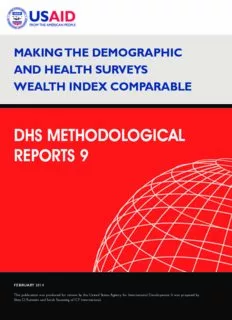Table Of ContentMaking the DeMographic
anD health SurveyS
Wealth inDex coMparable
DHS METHODOLOGICAL
REPORTS 9
February 2014
This publication was produced for review by the United States Agency for International Development. It was prepared by
Shea O. Rutstein and Sarah Staveteig of ICF International.
DHS Methodological Reports No. 9
Making the Demographic and Health Surveys
Wealth Index Comparable
Shea O. Rutstein
Sarah Staveteig
ICF International
Rockville, Maryland, USA
February 2014
Corresponding author: Shea O. Rutstein, Demographic and Health Research Division, ICF International, 530
Gaither Drive, Suite 500, Rockville, MD 20850; Phone: 301-572-0950; Fax: 301-572-0999; Email:
[email protected]
Acknowledgments: The authors are grateful to Tom Pullum for his advice and to Mark Montgomery for
his review. We would also like to thank Sidney Moore for editing the document and Yuan Cheng for
formatting it.
Editor: Sidney Moore
Document Production: Yuan Cheng
This study was carried out with support provided by the United States Agency for International
Development (USAID) through the MEASURE DHS project (#GPO-C-00-08-00008-00). The views
expressed are those of the authors and do not necessarily reflect the views of USAID or the United States
Government.
Recommended citation:
Rutstein, Shea, and Sarah Staveteig. 2014. Making the Demographic and Health Surveys Wealth Index
Comparable. DHS Methodological Reports No. 9. Rockville, Maryland, USA: ICF International.
Contents
Tables and Figures ...................................................................................................................................... v
Preface ........................................................................................................................................................ vii
Executive Summary .................................................................................................................................. iix
1 Introduction ......................................................................................................................................... 1
1.1 Need for a Comparative Wealth Index ............................................................................................ 2
1.2 Alternate Measures of Economic Status and Poverty ...................................................................... 3
2 Methods ................................................................................................................................................ 7
2.1 The Procedure in Brief ..................................................................................................................... 7
2.2 Selection of the Baseline Survey ..................................................................................................... 7
2.3 Selection and Calculation of the Anchoring Points ......................................................................... 7
2.4 Transformation of Country-specific Wealth Indexes ....................................................................... 9
2.5 Survey Inclusion and Survey-specific Adjustments ...................................................................... 10
2.6 Illustration of the Process ............................................................................................................... 11
2.7 Sensitivity Testing ......................................................................................................................... 12
2.8 Establishing a Monetary Equivalent .............................................................................................. 13
3 Results ................................................................................................................................................ 15
3.1 Levels of Wealth ............................................................................................................................ 15
3.2 Trends in Wealth ............................................................................................................................ 23
4 Example Applications ....................................................................................................................... 29
4.1 Infant and Child Mortality ............................................................................................................. 29
4.2 Fertility ........................................................................................................................................... 31
4.3 Maternal Health Care ..................................................................................................................... 32
4.4 Children’s Nutritional Status ......................................................................................................... 34
5 Conclusions and Limitations ............................................................................................................ 37
5.1 Summary ........................................................................................................................................ 37
5.2 Limitations ..................................................................................................................................... 37
5.3 Further Research ............................................................................................................................ 38
References .................................................................................................................................................. 39
Appendix A: Summary of Information from DHS Surveys .................................................................. 43
iii
Tables and Figures
Table 2.1 Calculation of wealth index cutpoints for 2006 Benin DHS using 2002 Vietnam DHS as
baseline ....................................................................................................................................... 11
Table 2.2 Results of comparison of 2006 Benin DHS wealth index and 2002 Vietnam DHS wealth
index ........................................................................................................................................... 12
Table 3.1 Values of comparative wealth index in relation to baseline, mean and standard deviation,
DHS surveys, 1990-2012 ............................................................................................................ 15
Table 3.2 Mean comparative wealth index by region, average of means and average of standard
deviations (SD), DHS surveys .................................................................................................... 19
Table 3.3 Trends in mean comparative wealth index score by country ...................................................... 23
Table 3.4 Trends in mean comparative wealth index score by region, DHS surveys 1998-2012 .............. 24
Table 4.1 Infant and under-5 mortality: Deaths per 1,000 live births, 52 latest DHS surveys since
2003 ............................................................................................................................................ 30
Table 4.2 Fertility: Whether women 15-49 had a birth in the year preceding the survey, 52 latest
DHS surveys since 2003 ............................................................................................................. 31
Table 4.3 Maternal health: Proper prenatal care (four or more visits starting in the first trimester of
pregnancy) and delivery in a health facility, last birth in the five years preceding survey ......... 33
Table 4.4 Nutritional status indicators (stunting and wasting) for children age 0-59 months, 52 latest
DHS surveys since 2003 ............................................................................................................. 35
App.Table A.1 Surveys completed for comparative wealth index, number of anchoring regression
points used, and missing variables, DHS surveys 1991 - 2012 .................................................. 43
Figure 2.1 Summary of anchoring cutpoints used for calculation of the experimental Comparative
Wealth Index ............................................................................................................................... 10
Figure 3.1a Comparative wealth indexes for DHS surveys, by level of mean CWI score, 1990-2012 ...... 20
Figure 3.1b List of the names of the surveys .............................................................................................. 21
Figure 3.2 Mean of comparative wealth index (CWI) versus gross national income per capita at
purchasing power parity (GNI/p at ppp), DHS surveys .............................................................. 25
Figure 3.3 Relationship between the survey mean of the comparative wealth index (CWI) and the
logarithm of gross national income per capita (Ln GNI/p), observed points and fitted line,
DHS surveys ............................................................................................................................... 26
v
Preface
The Demographic and Health Surveys (DHS) Program has become one of the principal sources of
international data on fertility, family planning, maternal and child health, nutrition, mortality, and
HIV/AIDS. The relationship between these indicators and economic status is of utmost importance to
researchers and policymakers worldwide.
One of the objectives of The DHS Program is to advance the methodology and procedures used to carry
out national-level surveys as well as to offer additional tools for analysis. This will improve the accuracy
and depth of information relied on by policymakers and program managers in developing countries.
The topics in the DHS Methodological Reports series are selected by The DHS Program staff in
consultation with the U.S. Agency for International Development. While data quality is a main topic of
the reports, they also examine issues of sampling, questionnaire comparability, survey procedures, and
methodological approaches.
It is hoped that the DHS Methodological Reports series will be useful to researchers, policymakers, and
survey specialists, particularly those engaged in work in developing countries.
Sunita Kishor
Director, The DHS Program
vii
Description:calculating wealth indexes that are comparable across surveys and time .. inspired by Amartya Sen's seminal work on the measurement of poverty

